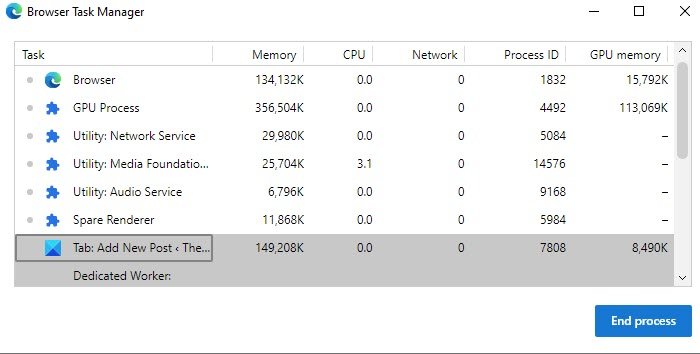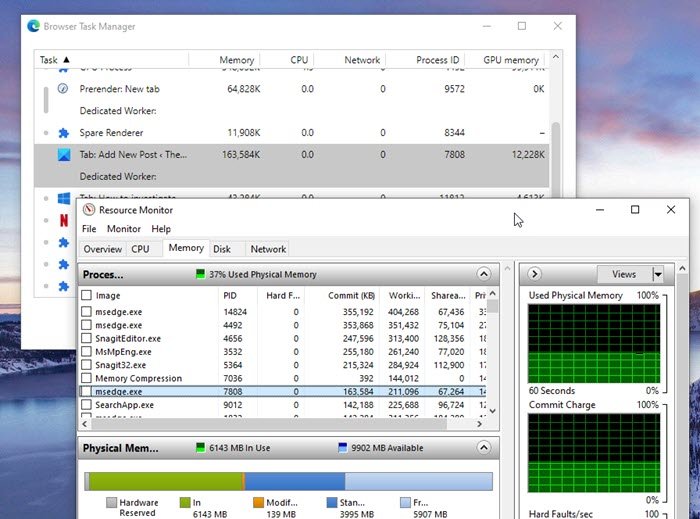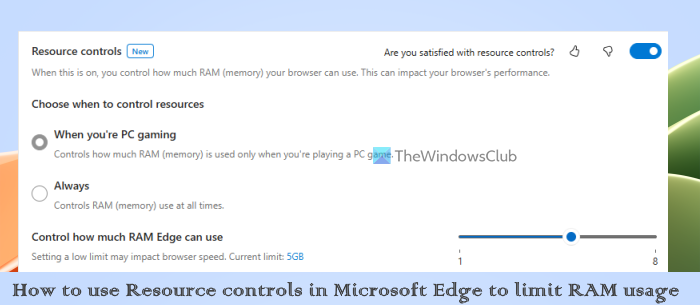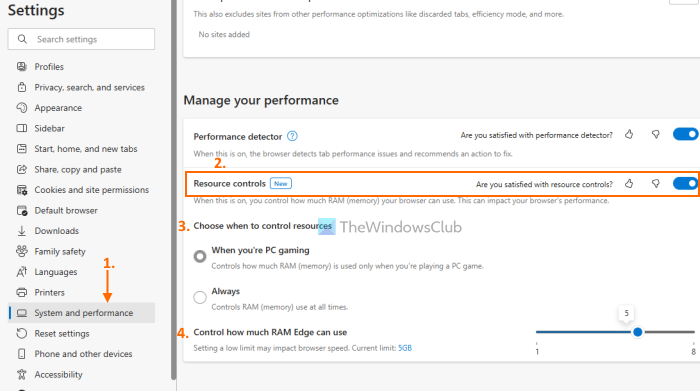While Microsoft Edge uses the same Chromium Engine as the Chrome browser, the CPU and RAM usage is drastically less. That said, it is still possible that the Edge browser may start consuming more resources, and that’s where the guide will come in handy. This post offers suggestions to help you when Microsoft Edge gets into a high memory usage situation. We will also show you how to use Resource controls in Microsoft Edge to limit RAM usage.
Fix Microsoft Edge High Memory Usage

If you see your computer or browsing getting slow while using the Edge browser, it’s a good idea to investigate first.
Open Task Manager (Ctrl + Shift + Esc), and sort it by memory usage.
- If it is something other than Edge consuming process and memory, you need to check on that application.
- If it is the Edge browser, let’s take a look into more details.
Use Edge Browser Task Manager to check Tab Memory Usage
Did you know the browser also offers a built-in task manager? It helps you know how much memory each open tab is consuming. That’s important because a particular website may take many resources, slowing the experience.

When on Edge browser, press Shift+Esc, to bring up the browser’s task manager. It will reveal all the tasks, including the Browser, GPU process, Network Service, Audio, video services, and memory usage of each tab and the extensions.
That said, the Microsoft Edge Team has its own recommendation on how much memory each of these processes inside the Browser can take. Here is the list of the maximum each of these processes should take:
- Browser process: 400 MB. This can be pushed up as you open more tabs.
- Renderer process: 500 MB. Playing video, social news feeds, and more.
- Subframe process: 75 MB. This can extend if there are complex ads, especially those playing videos.
- GPU Process: 1.75GB
- Utility process: 30 MB
- Extension process and plug-in processes: 15-0 MB
Windows reserves an amount of memory that can come in handy when it’s needed. It is also called as Commit charge and is based on the amount of Page Size. When Edge launches, it asks for committed memory space, and Windows offers it through Page Size or Virtual Memory. This is all dynamic, so even if a program asks for 3 GB and utilizes only 500 MB, the rest is still free.
Factors that impact Edge memory usage
Microsoft Edge does not always use much memory. The amount of RAM used by Edge and any other web browser depends on several factors, including the number of tabs, advertisements, web browser extensions, content, screen resolution, window size, and the number of browser windows opened.
How to reduce the memory usage in Edge?
If you see any open tab or extensions taking a lot of memory compared to others, close it, or uninstall the extension. Once you close, and the resources usage drops, then the problem is with whatever was open in that tab. Make sure to compare to the value we just shared above.
A second method to figure out if any background process or inactive tab in Microsoft Edge is consuming is to look through the Private work set. Consider this as a subpart of the Edge Process, and according to Microsoft, more than 80% of a commit in the private working set, and that is not the active tab, would be considered excessive.
The keyword is the Active Tab, which means a tab taking too much memory in the background is problematic.
We will use the Resource Manager and the Browser’s task manager to determine which is using most of the committed memory.

Type Resource Monitor in the Start menu, and click to launch once it is in the list, Sort by name so you can see the msedge.exe process and the commit size.
Next, on the Edge browser, use Sift+Esc to open the browser’s task manager. Right-click on the columns, and select PID, Commit Size, Memory (Private working set), Name, Status, User Name, and CPU
Note the PID, which takes a lot of resources, and then switch to Windows Task Manager. If the process’s private working set exceeds 80% of your commit, close it. You will also need to report it to Microsoft.
Related: How to Disable or Enable Performance Mode in Microsoft Edge
How to use Resource controls in Microsoft Edge to limit RAM usage
Resource controls is a new feature of Microsoft Edge. When turned on, you can control how much memory (RAM) the browser can use from the total available system memory which overall affects browser performance. We already have an Efficiency mode feature in Microsoft Edge for memory management, reducing background tab activity, limiting computer resources while playing games, etc. Now this Resource controls feature makes the browser and user experience better.

This Resource controls feature has been recently introduced, so, you should update your browser (if not already) to have and use this feature.

Here are the steps to use the Resource controls feature of Edge browser for limiting RAM usage on a Windows 11/10 PC:
- Open the Microsoft Edge browser
- Click on Settings and more icon (three horizontal dots) available on the top right part or press Alt+F hotkey
- Click on the Settings option in the menu that appears
- In the Settings page, select the System and performance category from the left sidebar
- Scroll down the page and access the Manage your performance section
- Turn on the Resource controls button
- Now you can select when to control resources. Available options are:
- Always
- When you’re PC gaming
- Once you’ve selected an option, you can use the Control how much RAM Edge can use slider to set the RAM limit.
When you don’t want to use this feature, you can turn off the Resource controls button.
Other things you can try if Edge shows high memory or CPU usage
- Open
edge://settings/systemand turn off Use hardware acceleration when available - Open
edge://settings/startHomeNTPand turn off Preload the new tab page for a faster experience setting - Clear Edge browser cache regularly
- Remove unwanted browser extensions, addons, and themes
- Reset Microsoft Edge browser
- Use the Modify/Reinstall button in Settings.
- Open Settings > Apps > Apps and features and search for Edge. Press Modify. This will reinstall Edge, and you will see a new icon placed on the desktop.
- If nothing helps, download and fresh-install Microsoft Edge.
To summarize – A browser can become resource-hungry and slow down a computer, but the browser might not be at fault. It could be an open tab, an extension running in the background, or a website that slows down the computer. The only way to figure it out is to check if it is taking resources and close it.
Sometimes, processes like GPU, Audio-video service, and network service are at fault. Restarting the browser might help.
If you need to keep the website open, close other tabs and work with them. You can also use another browser, check if the issue persists, and finish the work.
I hope the post helped you determine why your Microsoft Edge caused high memory usage.
How much RAM does Microsoft Edge use?
It depends on the number of tabs, installed extensions, and browser usage. With 4-5 tabs and continuous usage, Microsoft Edge can consume memory between 300-900 MB. However, if the Edge browser consumes a lot of memory (RAM), then you can enable Efficiency mode to keep the Balanced savings or Maximum savings for optimizing the performance. Turning on the Resource controls feature is also very helpful in controlling memory usage.
Read: Enable high-performance GPU for Edge browser
Why does Microsoft Edge take so much RAM?
It can happen because of the number of processes and services (like GPU Process, Storage Service, Network Service, etc.) running in the background. Installed extensions can also cause Microsoft Edge to consume high memory. Even if you are not using extensions, these can consume memory in the background. You can use Browser Task Manager of Microsoft Edge to keep an eye on the running tasks. For each task, memory, network, and CPU usage is provided. If some tasks are consuming too much RAM or CPU usage unnecessarily, you can select those tasks, and end the process.
Read: How to configure Tracking Prevention & Privacy Settings in Microsoft Edge.
How do I fix high memory usage on Windows 11?
There are multiple reasons why your RAM usage is high on Windows 11. Every program requires some amount of memory to run on Windows. RAM consumption increases when you open multiple programs. Closing the opened programs free up memory and the RAM usage returns to normal. However, if you see high memory usage even if no or fewer program(s) are running, there might be some hardware or software issues. To fix high memory usage, you can try some fixes, like repairing your system files, running a Chkdsk scan, updating drivers, running the memory diagnostic tool to check your RAM health, etc.
Read next: Microsoft Edge won’t open on Windows 11.
Leave a Reply